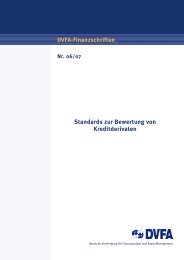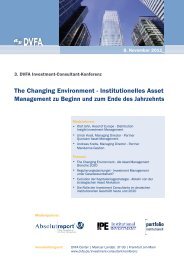KPIs for ESG - DVFA
KPIs for ESG - DVFA
KPIs for ESG - DVFA
You also want an ePaper? Increase the reach of your titles
YUMPU automatically turns print PDFs into web optimized ePapers that Google loves.
III. <strong>ESG</strong>s (Topical Areas) and Key Per<strong>for</strong>mance Indicators<br />
1. <strong>ESG</strong>s and <strong>KPIs</strong><br />
Topical areas are called <strong>ESG</strong>s. <strong>ESG</strong>s describe the general purpose of issues to be reported. <strong>ESG</strong>s serve as an<br />
overarching description of the issue at hand, and explain the rationale behind the KPI.<br />
<strong>ESG</strong>s are not the actual items to be reported. The actual item should be reported in the <strong>for</strong>mat of a KPI, i.e. the line<br />
item to be reported.<br />
The <strong>ESG</strong> serves as the denominator. <strong>KPIs</strong> need to be chosen from the list included and they represent the actual line<br />
items to be reported.<br />
2. General <strong>ESG</strong>s and sector-specific <strong>ESG</strong>s<br />
General <strong>ESG</strong>s apply to all industries and should, hence, be areas which should be reported in the <strong>for</strong>mat of a KPI by all<br />
corporates. Sector-specific <strong>ESG</strong> apply to specific industries only. General <strong>ESG</strong>s, however, are not more important than<br />
sector-specific <strong>ESG</strong>s. Rather, in order to arrive at a representative and authentic reporting picture, corporates should<br />
report on all issues within the section of the general <strong>ESG</strong>s by selecting those <strong>KPIs</strong> which represent the minimum<br />
requirement. This is typically a set of 1 KPI reflecting an absolute value and 1 KPI reflecting a level of intensity.<br />
<strong>KPIs</strong> <strong>for</strong> general <strong>ESG</strong>s should be disclosed by all industries. Sector-specific <strong>ESG</strong>s should be reported additionally to<br />
depict issues relevant to the respective sector.<br />
We have identified 10 general <strong>ESG</strong>s <strong>for</strong> Extra/Non-Financials, which – following the common usage – are structured<br />
into E, S, G, and V (short <strong>for</strong> long-term viability).<br />
Corporates should use each of the general <strong>KPIs</strong>, reporting those <strong>KPIs</strong> featured which represent the generally binding<br />
minimum requirement.<br />
3. Sector-specific <strong>ESG</strong>s and their respective <strong>KPIs</strong><br />
Thorough <strong>ESG</strong> reporting allows corporates to track and disclose those issues specific and peculiar to their sector.<br />
Often, differences between industries surface not only at the level of <strong>KPIs</strong>, but also in the context of <strong>ESG</strong>s.<br />
As the most important point of progress from version 1.2 to version 3.0 this paper provides sector-specific <strong>KPIs</strong> <strong>for</strong> all<br />
subsectors following the Dow Jones Industry Classification Benchmark (ICB). In all, sector-specific <strong>KPIs</strong> were developed<br />
<strong>for</strong> 114 subsectors.<br />
Corporates should identify the subsectors in which they operate and report all <strong>ESG</strong>s – both general and specific –<br />
identified and described <strong>for</strong> the specific subsector. Conglomerates should report <strong>for</strong> all subsectors in which they<br />
operate.<br />
4. Additional in<strong>for</strong>mation<br />
<strong>KPIs</strong> should be fairly self-explanatory and lend themselves to relatively easy integration with spreadsheet models.<br />
This, if anything, is the raison d’être of our <strong>KPIs</strong>. However, we acknowledge that “numbers” are often reflections of<br />
economic processes which do not allow deference to the underlying processes. Explanations and additional reference<br />
may be helpful to put <strong>ESG</strong> data into context. Deliberately, however, we do not encourage corporates to report<br />
narrative-style or prose text - except <strong>for</strong> KPNs (Key Per<strong>for</strong>mance Narratives) <strong>for</strong> all specified <strong>ESG</strong>s with a limited<br />
number of words and providing answers to the question we pose.<br />
We ask corporates to provide additional contextual in<strong>for</strong>mation deemed necessary <strong>for</strong> the interpretation of the<br />
respective KPI in annotations which should be linked to the KPI reported. The number and scope of annotations<br />
should be kept minimal.<br />
© <strong>DVFA</strong> April 2010 ALL RIGHTS RESERVED. No part of this publication may be reproduced, stored in a retrieval system, or transmitted, in any <strong>for</strong>m or by any<br />
means, electronic, mechanical, recording, without the prior permission of the copyright holder.<br />
11

















